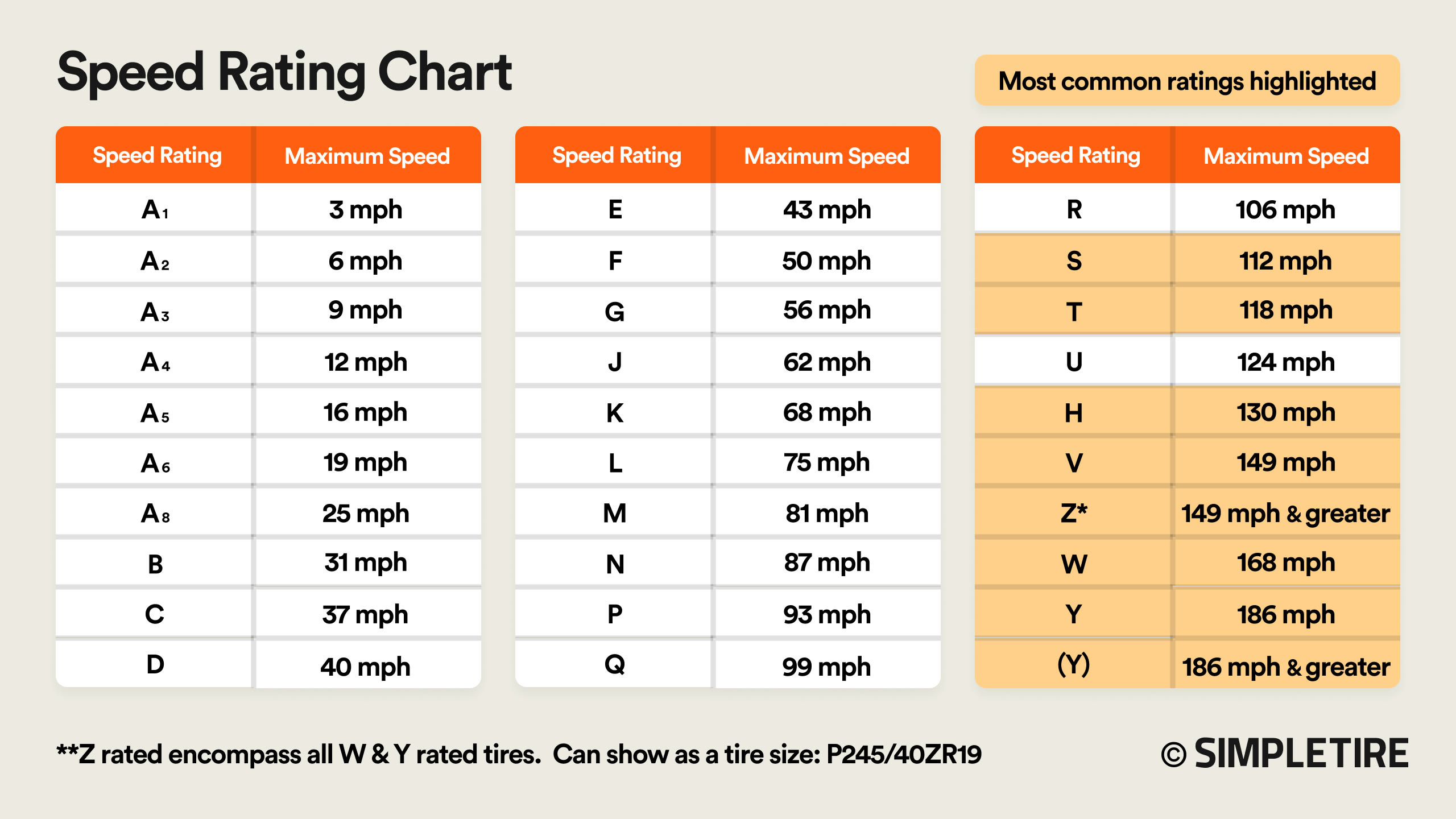tire buying guides
Tire Speed Rating Chart
Speed ratings inform automakers and vehicle owners of the maximum speed capability of their tires. Here’s everything else you should know about tire speed ratings.

Best price guarantee
Tire replacement coverage
24/7 roadside assistance
Easy returns
tire buying guides
Speed ratings inform automakers and vehicle owners of the maximum speed capability of their tires. Here’s everything else you should know about tire speed ratings.

When most people purchase tires, they are usually concerned about price, size, and how many miles they might last. People don't pay much attention to the speed ratings of the tires.
However, tire speed rating should be a crucial part of the selection process when you are buying new tires because it is vital to how your vehicle performs.
Tire speed ratings were created in Europe with the intention of balancing tire speed capabilities with vehicle capability. This was particularly crucial on Germany's Autobahns, which had no speed limits. The safety of the driver and passengers would have been severely put in danger if the tires in use exceeded their maximum speed capability by a significant amount. Speed ratings are used nowadays to advise automakers and vehicle owners of the top speed that a tire can travel at.
A tire speed rating testing device is used by tire makers to determine a tire's heat and speed tolerance. Testing Speed rating on tires is performed by using a scale based on kilometers per hour (km/h) to ensure compliance with ECE (Economic Commission for Europe) standards. In order to meet SAE (Society of Automotive Engineers) requirements, a more demanding tire speed rating test may occasionally be conducted.
For the ECE test, the tire is installed on a wheel attached to a testing apparatus with the necessary air pressure inside a room that is heated to 77 degrees Fahrenheit. The tire is then exerted enough pressure against a metal drum to represent a real load. Tires are run at increasing speeds of 6.2 mph in 10-minute intervals to verify speed ratings. The test is carried out repeatedly until the tire's producer receives the desired speed rating.

The predetermined maximum operating speed for a particular tire is verified by the tire makers through a series of carefully monitored laboratory tests. The application of the tire, the compounds used to make it, and the likelihood of failure at speeds deemed excessive for the tire are just a few of the elements that the tire manufacturer takes into account when determining the maximum operating speed.
View our tire speed rating chart below:
When vehicles are built, the size, load, and speed ratings that will eventually be put on them are tested on the vehicles. The guidelines for particular vehicles also depend on the suspension and engine choices. Different speed and load ratings cause tires to behave differently. Downgrading the speed or load ratings of the tires fitted to the vehicle might affect cornering and overall vehicle control. Performance standards for vehicles with higher speed classifications differ. For performance purposes, a lot of import manufacturers attach tires with greater speed ratings to their cars.
The top speeds that tires can safely bear are simply indicated by their speed ratings. In other words, they only quantify performance rather than having any personal impact on it. The owner's manual for your car will have the recommended tire speed rating. The vehicle's maximum operational speed is often capped at the lowest tire speed rating assigned to the tires that are currently mounted on it as a safety measure for the driver and passengers.
Nearly every tire produced in the United States, Canada, Europe, and other regions of the world has speed ratings on the sidewalls. A unique alphanumeric code that also indicates the tire's width, sidewall height, and wheel diameter size contains the rating. With "S" standing for the speed rating, this code can be seen on the sidewall in one of the following formats:
225/50R16 89S
From "L," which represents the lowest-rated tire (75 mph), to "(Y)," which is reserved for extreme sports automobiles capable of speeds over 186 miles per hour, each speed rating is given an alphabetical letter. Family cars, vans, and light-duty trucks are rated "P" (93 mph) to "T" (118 mph) by the majority of everyday drivers. Tires with a "V" rating (149 mph) and made from performance-oriented compounds are frequently found on sports sedans and coupes.
A tire’s speed rating indicates the optimal speed that the tire can safely maintain over time. In short, it’s the fastest speed a tire can handle before it no longer performs as designed. The higher the speed rating, the better control and handling you’ll have at higher speeds.
Yes, tire speed rating matters because a higher speed rating usually means you will have better control and handling at higher speeds — and that the tire can take the extra heat that comes with high-speed driving. As a general rule, tires with higher speed ratings also handle better at slower speeds.
Search By